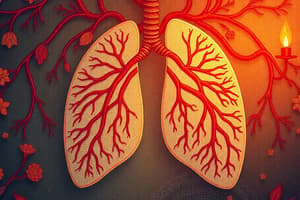Podcast
Questions and Answers
What is the major role of conducting arteries?
What is the major role of conducting arteries?
Carry blood to smaller arteries
What are the major components of elastic arteries' media?
What are the major components of elastic arteries' media?
Elastic lamellae and smooth muscle fibers
How many elastic lamellae does the adult aorta typically have?
How many elastic lamellae does the adult aorta typically have?
About 50
What is the function of carotid sinuses in the arterial system?
What is the function of carotid sinuses in the arterial system?
Which cranial nerve provides sensory nerve endings to the adventitia of carotid sinuses?
Which cranial nerve provides sensory nerve endings to the adventitia of carotid sinuses?
What is the role of baroreceptors in the aortic arch?
What is the role of baroreceptors in the aortic arch?
What are the two major divisions that make up the circulatory system?
What are the two major divisions that make up the circulatory system?
What are the three main components found in the walls of all blood vessels?
What are the three main components found in the walls of all blood vessels?
What is the endothelium, and what is its function?
What is the endothelium, and what is its function?
How are vascular endothelial cells shaped?
How are vascular endothelial cells shaped?
What are some functions of the endothelium related to clot formation?
What are some functions of the endothelium related to clot formation?
How are the amount and arrangement of tissues in blood vessels influenced?
How are the amount and arrangement of tissues in blood vessels influenced?
What are the main components of the chemoreceptors in the carotid and aortic bodies?
What are the main components of the chemoreceptors in the carotid and aortic bodies?
What stimuli do the ion channels in the glomus cell membranes respond to?
What stimuli do the ion channels in the glomus cell membranes respond to?
Which nerve forms synapses with the glomus cells in the carotid and aortic bodies?
Which nerve forms synapses with the glomus cells in the carotid and aortic bodies?
What neurotransmitters are contained in the dense-core vesicles of the glomus cells?
What neurotransmitters are contained in the dense-core vesicles of the glomus cells?
What is the main function of the muscular arteries in the body?
What is the main function of the muscular arteries in the body?
What is the role of the internal elastic lamina in muscular arteries?
What is the role of the internal elastic lamina in muscular arteries?
What is the last component of the media in larger muscular arteries?
What is the last component of the media in larger muscular arteries?
What do arterioles indicate the beginning of in an organ's microvasculature?
What do arterioles indicate the beginning of in an organ's microvasculature?
What is absent in arterioles, unlike in larger arteries?
What is absent in arterioles, unlike in larger arteries?
What type of muscle cells make up the media in arterioles?
What type of muscle cells make up the media in arterioles?
What surrounds the parenchymal cells of an organ?
What surrounds the parenchymal cells of an organ?
What structures are found in the adventitia of arteries?
What structures are found in the adventitia of arteries?
What is the function of smooth muscle fibers in arterioles?
What is the function of smooth muscle fibers in arterioles?
What specialized function do arterioles serve in thermoregulation by the skin?
What specialized function do arterioles serve in thermoregulation by the skin?
How are arteriovenous shunts different from regular arterioles?
How are arteriovenous shunts different from regular arterioles?
What is the role of autonomic fibers at arteriovenous shunts?
What is the role of autonomic fibers at arteriovenous shunts?
What is the benefit of high capillary blood flow in the skin?
What is the benefit of high capillary blood flow in the skin?
Describe the venous portal system and its purpose.
Describe the venous portal system and its purpose.
Flashcards are hidden until you start studying




